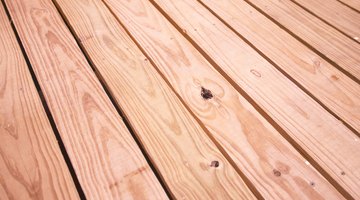Types of Wood Finishes
Table of Contents
There are several types of finishes available for wood. A few finishes that you can choose from are clear stains, solid stains, paint, natural finishes and varnishes. The choice of finish is based entirely on your personal preference. Wood finishes are relatively easy to apply, but not always so easy to remove.

Use a scrap piece of wood made of the same wood type, and apply your choice of finish to it. This will give you a visual idea of what your wood project will look like.
Clear Stain

Clear stains, when applied, will still allow you to see the wood grain. You can use a paint brush or a rag to apply this type of stain. Brush the stain on and use a rag to wipe off the excess. You can also just dip a rag into the stain and wipe it onto the wood. After you have stained the wood you will need to apply a clear-coat finish. It is best to allow the stain to dry overnight before applying the clear coat. Using clear coat will seal and protect your wood from the possibility of water damage.
Solid Stain

Solid stains are not opaque. This means that you cannot see the wood grain through the stain unless the wood is heavily grained. One particular type of heavily grained wood is oak. Solid stains are applied in the same manner as clear stains, and must be clear-coated when used on furniture or interior trim. People often choose solid stains for use on exterior cedar trim and siding.
Paint

Two basic types of paint used to finish wood are latex and oil. Latex paints are water-based and will clean up with water; oil paints are oil-based and will clean up with paint thinner or mineral spirits. Oil base paint is best used on furniture and trim. This type of paint is stronger than latex, and will hold up to more wear and tear. Latex paint is best used when painting the wood surfaces on the outside of your home. You must use a latex or oil primer before using latex or oil paint.
Natural Finish

You do not have to use stain or paint to finish your wood. Some people prefer the look of natural wood without adding any color to it. To obtain a natural finish you only need to use a clear-coat wood sealer. Clear-coating your wood will not alter the color; it will preserve it. You must apply two coats and sand between each coat. The first application of a clear coat will raise the wood grain. Raised wood grain is rough to the touch, but will become smooth after it is sanded. Wipe off the excess dust from sanding before you apply a second coat. Clear coats are brushed on or sprayed.
Varnish

Varnish is a very strong finish for any wood project. Varnish withstands weather and is resistant to chemicals. With varnish there is no need to use a clear-coat protective finish; it is a stain and sealer all in one product. Your wood must be sanded smooth and free of dust to obtain a fine finish. You need to apply at least a minimum of two coats of varnish, and sand with a fine grit sandpaper between coats. Varnish is best applied with a brush or rag.
The Drip Cap
- There are several types of finishes available for wood.
- Using clear coat will seal and protect your wood from the possibility of water damage.
- One particular type of heavily grained wood is oak.
- To obtain a natural finish you only need to use a clear-coat wood sealer.
- The first application of a clear coat will raise the wood grain.
- Clear coats are brushed on or sprayed.
- Varnish withstands weather and is resistant to chemicals.
- With varnish there is no need to use a clear-coat protective finish; it is a stain and sealer all in one product.
References
Writer Bio
Based in Oklahoma City, Debbie Tolle has been working in the home-improvement industry since 2001 and writing since 1998. Tolle holds a Master of Science in psychology from Eastern Illinois University and is also a Cisco-certified network associate (CCNA) and a Microsoft-certified systems engineer (MCSE).
Photo Credits
- Jupiterimages/BananaStock/Getty Images
- Jupiterimages/BananaStock/Getty Images
- Jupiterimages/liquidlibrary/Getty Images
- Jupiterimages/BananaStock/Getty Images
- Stockbyte/Stockbyte/Getty Images
- Jupiterimages/Photos.com/Getty Images
- Stockbyte/Stockbyte/Getty Images
More Articles



